
FIG. 7
least the minimum wire size. The following table shows the correct size to use depending
on cord length and nameplate ampere rating. If in doubt, use the next heavier gauge. The
smaller the gauge number, the heavier the cord.
Recommended Minimum Wire Size for Extension Cords
Total Length of Cord
25 ft. 50 ft. 75 ft. 100 ft. 125 ft. 150 ft. 175 ft.
7.6 m 15.2 m 22.9 m 30.5 m 38.1 m 45.7 m 53.3 m
Wire Size AWG
18 18 16 16 14 14 12
• Do not place any object on top of charger or place the charger on a soft surface
that might block the ventilation slots and result in excessive internal heat. Place the
charger in a position away from any heat source. The charger is ventilated through slots
in the top and the bottom of the housing.
• Do not operate charger with damaged cord or plug.
• Do not operate charger if it has received a sharp blow, been dropped, or otherwise
damaged in any way. Take it to an authorized service center.
• Do not disassemble charger; take it to an authorized service center when service or
repair is required. Incorrect reassembly may result in a risk of electric shock, electrocution
or fire.
• Disconnect the charger from the outlet before attempting any cleaning. This will
reduce the risk of electric shock. Removing the battery pack will not reduce this risk.
• NEVER attempt to connect 2 chargers together.
• The charger is designed to operate on standard 120V household electrical power.
Do not attempt to use it on any other voltage. This does not apply to the vehicular
charger.
Using Automatic Tune-Up™ Mode
The automatic Tune-Up™ Mode equalizes or balances the individual cells in the battery pack
allowing it to function at peak capacity. Battery packs should be tuned up weekly or after
10 charge/discharge cycles or whenever the pack no longer delivers the same amount of
work. To use the automatic Tune-Up™, place the battery pack in the charger and leave it for
at least 8 hours. The charger will cycle through the following modes.
1. The red light will blink continuously indicating that the 1-hour charge cycle has started.
2. When the 1-hour charge cycle is complete, the light will stay on continuously and will no
longer blink. This indicates that the pack is fully charged and can be used at this time.
3. If the pack is left in the charger after the initial 1-hour charge, the charger will begin the
Automatic Tune-Up™ mode. This mode continues up to 8 hours or until the individual
cells in the battery pack are equalized. The battery pack is ready for use and can be
removed at any time during the Automatic Tune-Up™ mode.
4. Once the Automatic Tune-Up™ mode is complete, the charger will begin a maintenance
charge; the red indicator will remain lit.
Chargers
Your tool uses a DEWALT 14,4 or 18 volt charger. Be sure to read all safety instructions
before using your charger. Consult the chart at the end of this manual for compatibility of
chargers and battery packs.
Charging Procedure (Fig. 2)
DANGER: Electrocution hazard. 120 volts present at charging terminals. Do not probe with
conductive objects. Danger of electric shock or electrocution.
1. Plug the charger into an appropriate outlet before inserting battery pack.
2. Insert the battery pack into the charger. The red (charging) light will blink continuously
indicating that the charging process has started.
3. The completion of charge will be indicated by the red light remaining ON continuously.
The pack is fully charged and may be used at this time or left in the charger.
Indicator Light Operation
Charge Indicators
Some chargers are designed to detect certain problems that can arise with battery packs.
Problems are indicated by the red light flashing at a fast rate. If this occurs, re-insert battery
pack into the charger. If the problem persists, try a different battery pack to determine if
the charger is OK. If the new pack charges correctly, then the original pack is defective
and should be returned to a service center or other collection site for recycling. If the new
battery pack elicits the same trouble indication as the original, have the charger tested at an
authorized service center.
HOT/COLD PACK DELAY
Some chargers have a Hot/Cold Pack Delay feature: when the charger detects a battery
that is hot, it automatically starts a Hot Pack Delay, suspending charging until the battery
has cooled. After the battery has cooled, the charger automatically switches to the Pack
Charging mode. This feature ensures maximum battery life. The red light flashes long, then
short while in the Hot Pack Delay mode.
PROBLEM POWER LINE
Some chargers have a Problem Power Line indicator. When the charger is used with some
portable power sources such as generators or sources that convert DC to AC, the charger
may temporarily suspend operation, flashing the red light with two fast blinks followed by
a pause. This indicates the power source is out of limits.
LEAVING THE BATTERY PACK IN THE CHARGER
The charger and battery pack can be left connected with the red light glowing indefinitely.
The charger will keep the battery pack fresh and fully charged.
NOTE: A battery pack will slowly lose its charge when kept out of the charger. If the battery
pack has not been kept on maintenance charge, it may need to be recharged before use.
A battery pack may also slowly lose its charge if left in a charger that is not plugged into an
appropriate AC source.
WEAK BATTERY PACKS: Chargers can also detect a weak battery pack. Such batteries
are still usable but should not be expected to perform as much work. The charger will indicate
to replace battery pack.
Important Charging Notes
1. Longest life and best performance can be obtained if the battery pack is charged when
the air temperature is between 65°F and 75°F (18°- 24°C). DO NOT charge the battery
pack in an air temperature below +40°F (+4.5°C), or above +105°F (+40.5°C). This is
important and will prevent serious damage to the battery pack.
2. The charger and battery pack may become warm to touch while charging. This is a
normal condition, and does not indicate a problem. To facilitate the cooling of the battery
pack after use, avoid placing the charger or battery pack in a warm environment such as
in a metal shed, or an uninsulated trailer.
3. If the battery pack does not charge properly:
a. Check current at receptacle by plugging in a lamp or other appliance;
b. Check to see if receptacle is connected to a light switch which turns power off when
you turn out the lights;
c. Move charger and battery pack to a location where the surrounding air temperature is
approximately 65°F - 75°F (18°- 24°C);
d. If charging problems persist, take the tool, battery pack and charger to your local
service center.
4. The battery pack should be recharged when it fails to produce sufficient power on jobs
which were easily done previously. DO NOT CONTINUE to use under these conditions.
Follow the charging procedure. You may also charge a partially used pack whenever you
desire with no adverse affect on the battery pack.
5. Under certain conditions, with the charger plugged into the power supply, the exposed
charging contacts inside the charger can be shorted by foreign material. Foreign
materials of a conductive nature such as, but not limited to, grinding dust, metal chips,
steel wool, aluminum foil, or any buildup of metallic particles should be kept away from
charger cavities. Always unplug the charger from the power supply when there is no
battery pack in the cavity. Unplug charger before attempting to clean.
6. Do not freeze or immerse charger in water or any other liquid.
WARNING: Shock hazard. Don’t allow any liquid to get inside charger. Electric shock may
result.
CAUTION: Never attempt to open the battery pack for any reason. If the plastic housing
of the battery pack breaks or cracks, return to a service center for recycling.
Storage Recommendations
1. The best storage place is one that is cool and dry away from direct sunlight and excess
heat or cold.
2. Long storage will not harm the battery pack or charger. Under proper conditions, they
can be stored for 5 years or more.
SAVE THESE INSTRUCTIONS FOR FUTURE USE
Motor
Your DEWALT tool is powered by a DEWALT-built motor. Be sure your power supply agrees
with the nameplate markings.
Voltage decrease of more than 10% will cause loss of power and overheating. All D
EWALT
tools are factory tested; if this tool does not operate, check your battery pack.
OPERATION
WARNING: To reduce the risk of serious personal injury, turn tool off and
disconnect tool from power source before making any adjustments or removing/
installing attachments or accessories.
Switch (Variable Speed) (Fig. 3)
LOCK-OFF BUTTON AND TRIGGER SWITCH
Your saw is equipped with a lock-off button (B).
To lock the trigger switch, press the lock-off button as shown in Figure 3. Always lock the
trigger switch (A) when carrying or storing the tool to eliminate unintentional starting. The
lock-off button is colored red to indicate when the switch is in its unlocked position.
SHOE
PATIN
BASE METÁLICA
TRIGGER SWITCH
GÂCHETTE
CONMUTADOR TIPO
GATILLO
HAND GRIP
POIGNÉE
EMPUÑADURA
LOCK-OFF BUTTON
BOUTON DE VERROUILLAGE
BOTÓN DE BLOQUEO EN OFF
(APAGADO)
A
FIG. 3
B
UNLOCKED
DÉVERROUILLÉ
DESBLOQUEADO
LOCKED
VERROUILLÉ
BLOQUEADO
FIG. 5
FIG. 2
FIG. 4
C
FIG. 6
FIG. 8
FIG. 9
FIG. 10
FIG. 12
To unlock the trigger switch, press the lock-off button as shown in Figure 3. Pull the trigger
switch to turn the motor ON. Releasing the trigger switch turns the motor OFF.
NOTE: This tool has no provision to lock the switch in the ON position, and should never be
locked ON by any other means.
The variable speed trigger switch will give you added versatility. The further the trigger is
depressed the higher the speed of the saw.
CAUTION: Use of very slow speed is recommended only for beginning a cut. Prolonged
use at very slow speed may damage your saw.
Installing and Removing the Battery Pack
NOTE: Make sure your battery pack is fully charged.
WARNING: Lock trigger switch before removing or installing battery.
To install the battery pack into the tool handle, align the base of the tool with the notch
inside the tool’s handle and slide the battery pack firmly into the handle until you hear the
lock snap into place as shown in Figure 4.
To remove the battery pack from the tool, press the release buttons and firmly pull the
battery pack out of the tool handle. Insert it into the charger as described in the charger
manual.
Blade Installation and Removal
WARNING: To reduce the risk of serious personal injury, turn tool off and
disconnect tool from power source before making any adjustments or removing/
installing attachments or accessories.
Different blade lengths are available. Use the appropriate blade for the application. The
blade should be longer than 3-1/2" and should extend past the shoe and the thickness of
the workpiece during the cut. Do not use jigsaw blades with this tool.
WARNING: Cut hazard. Blade breakage may occur if the blade does not extend past the
shoe and the workpiece during the cut (Fig. 5). Increased risk of personal injury, as well as
damage to the shoe and workpiece may result.
TO INSTALL BLADE INTO SAW
1. Open blade clamp release lever (C) up (Fig. 6).
2. Insert blade shank from the front.
3. Close blade clamp release lever down.
4. Note blade can be installed upside-down to assist in flush-to cutting, see Figure 10.
TO REMOVE BLADE FROM SAW
CAUTION: Burn hazard. Do not touch the the blade immediately after use. Contact with
the blade may result in personal injury.
1. Open up blade clamp release lever.
2. Remove blade.
Cutting with Blade in Horizontal Position (Fig. 7)
Your saw may or may not be equipped with a horizontal blade clamp. Installing a blade in the
horizontal orientation allows cutting close to floors, walls or ceilings where limited clearance
is available. Ensure that the shoe is pressed against the framing to avoid kickback.
Adjustable Shoe (Fig. 8)
Your saw may or may not come with an adjustable shoe. The shoe will adjust to limit the
depth of cut. Hold the saw with the underside facing up. Push the button on the hand grip
and slide the shoe out to one of the three settings and release the button.
CAUTION: Cut hazard. To prevent loss of control, never use tool without shoe.
Cutting (Fig. 9)
WARNING: Always use eye protection. All users and bystanders must wear eye
protection that conforms to ANSI Z87.1.
WARNING: Exercise extra caution when cutting towards operator. Always hold saw firmly
with both hands while cutting.
Before cutting any type of material, be sure it is firmly anchored or clamped to prevent
slipping. Place blade lightly against work to be cut, switch on saw motor and allow it to
obtain maximum speed before applying pressure. Whenever possible, the saw shoe must
be held firmly against the material being cut. This will prevent the saw from jumping or
vibrating and minimize blade breakage. Any cut which puts pressure on the blade such as
angle or scroll cuts increase potential for vibration, kickback, and blade breakage.
WARNING: Use extra caution when cutting overhead and pay particular attention to
overhead wires which may be hidden from view. Anticipate the path of falling branches and
debris ahead of time.
WARNING: Inspect work site for hidden gas pipes, water pipes, or electrical wires
before making blind or plunge cuts. Failure to do so may result in explosion, property
damage, electric shock, and/or serious personal injury.
FLUSH-TO CUTTING (FIG. 10)
The compact design of the saw motor housing and spindle housing permits extremely close
cutting to floors, corners and other difficult areas.
POCKET/PLUNGE CUTTING – WOOD ONLY (FIG. 11)
The initial step in pocket cutting is to measure the surface area to be cut and mark clearly with
a pencil, chalk or scriber. Use the appropriate blade for the application. The blade should be
longer than 3-1/2" and should extend past the shoe and the thickness of the workpiece during
the cut. Insert blade in blade clamp.
Next, tip the saw backward until the back edge of the shoe is resting on the work surface and
the blade clears the work surface. Now switch motor on, always permitting blade to attain
maximum speed. Grip handle steadily and begin a slow, deliberate upward swing with the
handle of the saw. Blade will begin to feed into material. Always be sure blade is completely
through material before continuing with pocket cut.
NOTE: In areas where blade visibility is limited, use the edge of the saw shoe as a guide.
Lines for any given cut should be extended beyond edge of cut to be made.
METAL CUTTING (FIG. 12)
This unit has different metal cutting capacities depending upon type of blade used and the
metal to be cut. Use a finer blade for ferrous metals and a coarse blade for non-ferrous
FIG. 11
ROCK TOOL UP TO NORMAL CUTTING
POSITION AFTER BLADE HAS CUT
THROUGH MATERIAL
STARTING POSITION FOR POCKET CUTTING
BALANCEE LA HERRAMIENTA
HACIA ARRIBA HASTA ALCANZAR
LA POSICIÓN NORMAL DE CORTE
LUEGO DE QUE LA HOJA
ATRAVIESE EL MATERIAL
POSICIÓN INICIAL PARA CORTES CENTRALES
PIVOTER L’OUTIL EN POSITION
NORMALE DE COUPE UNE FOIS
QUE LA LAME A TRAVERSÉ
LE MATÉRIAU.
POSITION DE DÉPART POUR COUPE INTERNE
FIG. 1


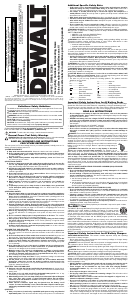

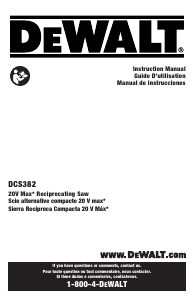
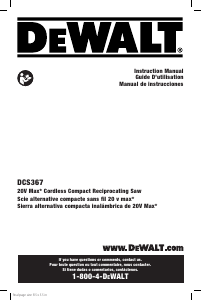
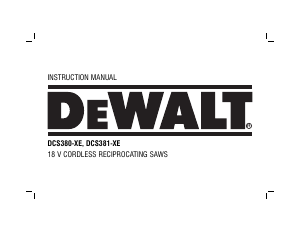
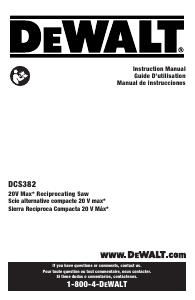
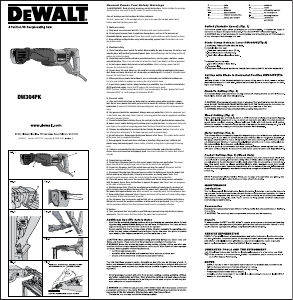

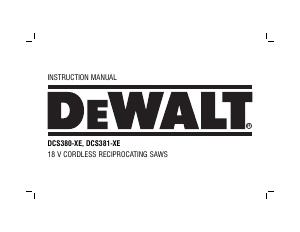
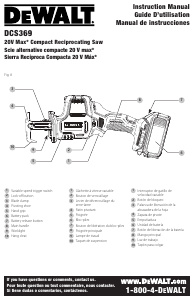
Join the conversation about this product
Here you can share what you think about the DeWalt DC385 Reciprocating Saw. If you have a question, first carefully read the manual. Requesting a manual can be done by using our contact form.